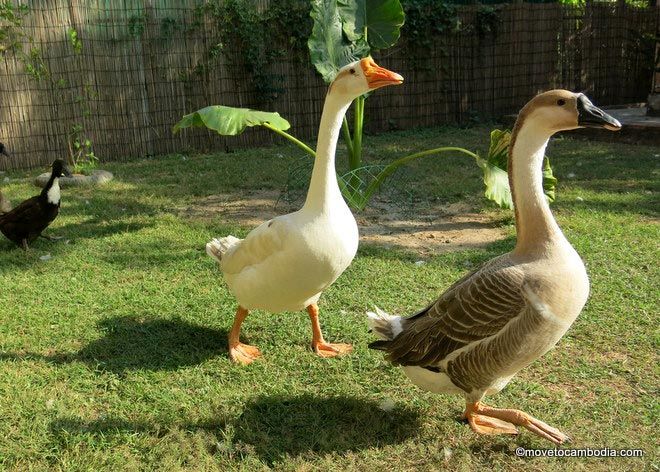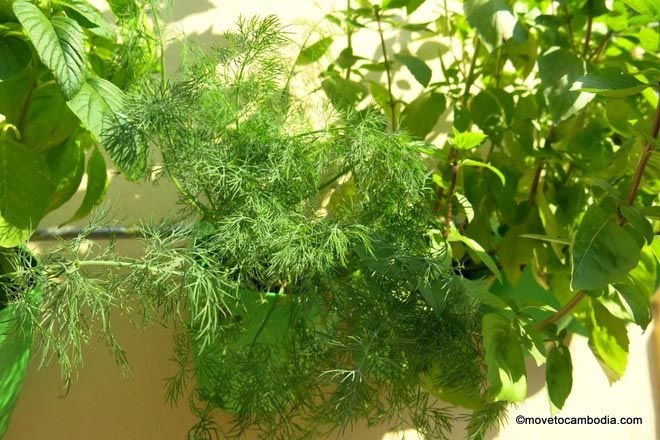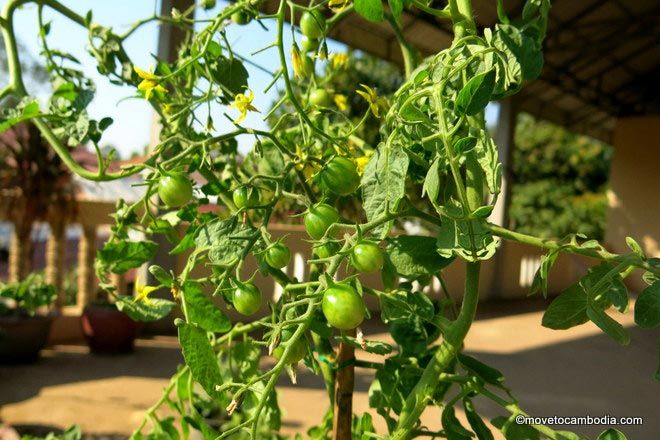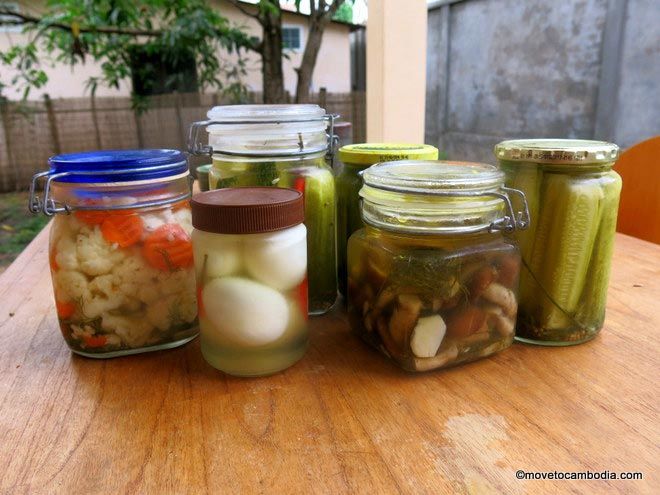I’ve always harbored fantasies of having a life like the Little House on the Prairie book series that I devoured as a kid: growing my own food, building houses, killing bears. And while I’m not ready or willing to commit to full self-sufficiency, my life as a Cambodia expat — and our move to Siem Reap — has allowed us to dabble in urban homesteading.

Starting with a bunch of seedlings to see what will actually grow well in Cambodia.
Urban homesteading encompasses a wide range of activities that are often associated with farm life, like growing your own food, canning, preserving, composting, and raising animals. Unlike real farmers, though, urban homesteaders live in suburbs or cities and so have limited space to work with. The brilliant designer of the Move to Cambodia book, Dan O. Williams, also designed one of the movement’s most inspirational tomes, The Backyard Homestead. He gave me a copy a few months ago and I attacked it like a kid on Christmas morning.
All my adult life I’ve lived in dense cities, and pretty much my biggest homestead was a window box filled with basil, oregano, and thyme. In Siem Reap, though, we’ve got a house with a garden big enough to allow us to grow our own food, or at least entertain fantasies of doing so. When I enquired about raising livestock, one of my neighbors waved aside the idea, telling me, “This is the city, not the provinces!” But he wasn’t too citified to add that if our geese had any babies, he’d like a few.

Contenders for the most spoiled geese in Cambodia.
One of the things I love about living in Cambodia is that there’s still a lot of flexibility about what you can do, and so much is still unregulated. Back in the U.S., many cities have laws against keeping chickens or ducks inside the city limits. Now I get woken up by roosters every morning, so I understand why those laws exist. But being a Siem Reap expat allows me to live out my sustainable-living fantasies while still living ten minutes away from a grocery store that stocks brie and Doritos.
Since we moved to Siem Reap we’ve slowly but surely started working our way towards our own rural idyll. The ducks and geese we’ve accumulated are just pets, but they certainly help contribute to my image of myself as a gentleman farmer. Our house came with five mango trees and two jackfruit trees, and we’ve since planted six papayas, a lime tree, a pomelo tree, a passionfruit, and two bananas. I have high hopes for the papayas and bananas; they’re both fast growers that can start bearing fruit in less than a year.
We planted three bananas, but the ducks attacked and demolished one of them. The ducks generally are not interested in my goal of raising my own food, and seem to think my goal is to raise their food: they spend most of their day trying to get around my creative attempts to keep them away from my seedlings.

We grow the herbs we can’t find at the market, including Italian basil and dill.
We’ve also made some raised beds, where we are starting with several types of beans and herbs that aren’t reliably available in Cambodia, including dill, Italian basil, and flat-leaf parsley. Cambodia expats have been griping for years about the lack of flat-leaf parsley (hint: you can buy it at Veggy’s in both Phnom Penh and Siem Reap occasionally), so I figured it would be worth trying to grow our own.
Outside of those window boxes I have no experience cultivating anything except a sense of dissatisfaction, so there’s been plenty of trial and error.We’ve seen a lot of Cambodians growing corn, so we’ve got a few stalks planted, as well as eggplants, peppers, and a few other random things here and there. Our green-bean plant decided to produce just a handful of beans before it expired, giving us a literal three bean salad (beans turn out to need more direct sun). We’ve got tomato plants on our roof that are just starting to fruit. Larger varieties of tomatoes don’t do well in Cambodia; they can’t get enough sun and the humidity causes their skin to split. So we planted several types of cherry tomatoes to see which would work.

And our roof is covered with cherry tomatoes.
It’s been a learning process. The plants that grow at home often won’t do as well in Cambodia. But with local vegetables and herbs very inexpensive at the market, focusing entirely on Asian vegetables didn’t seem very appealing. However, we’ve learned the hard way that cold-weather vegetables just don’t want to grow here. Our beets died and our kale has decided to remain microkale (although it still tastes good). We’re growing a few other local bits and bobs, like betel and lemongrass, and will probably add more as we give up on trying to grow things that don’t like this climate. I’ve also been looking for plants that aren’t native but might be able to handle the weather here; I’ve got a tomatillo plant that’s six inches tall that I’m holding out hope for, and have several types of pepper seeds on their way.
Because the soil in Siem Reap is so inhospitable to most plants — it’s sandy clay that has low nutrients — we’ve started composting to supplement it. Composting also gives me a sense of self-righteousness that more than makes up for the effort it takes.
It’s hard to overstate the privilege we experience as expats in Cambodia; for example, we’ve been able to hire a gardener to come once a week and help us figure out what we’re doing, something we wouldn’t be able to afford at home. He’s been transplanting local plants and helps create barriers to keep the ducks from eating them. We still need to do the bulk of the work and water everything on a daily basis, but having the help is an undeniable asset. Also fantastically helpful is being able to learn from the locals, who obviously know quite a lot more than we do about the best way to grow things here. Even in our relatively suburban neighborhood most of our neighbors have at least a few chickens and several fruit trees and other edibles growing.

It turns out you can pickle just about anything.
Canning and preserving are next on my list, and I’ve gotten obsessive about making pickles and various other fermented projects. Fermenting things is almost too easy here; fermentation can start in a matter of hours because of the heat. Right now I’ve got a vat of jackfruit hooch going, which I intend to make into vinegar, and I’ve been making kimchi and sauerkraut as well.
I’m alternately jealous of and daunted by the “real” homesteaders in the Cambodia expat community. While our garden is still mostly a barren wasteland, other expats have moved to Cambodia to fulfill their dreams of owning a proper farm and are happy to act as a resource for other would-be farmers. There are several online communities for Cambodia expats who are interested in agricultural topics: the Living in Cambodia forums are owned by an American farmer and have a decidedly barnyard focus, the Siem Reap Agricultural Network Facebook group is one of the best resources in the country, Phnom Penh Seed Shop sells seeds but can also offer growing guidance to amateur farmers, and Agriculture Consulting Team (ACT) in Cambodia is also worth a look.
Hi Lina,
Thank you for writing this. Moving soon to SR and planning a small vege garden once there. Looking forward to connect, so many questions to ask about urban homesteading in SR.
Hi Lina!
It made me so happy to read tour post :)
Can I buy cuttings, seeds and plants from you??
Thanks thanks thanks
If you’re in SR I would be happy to give you some seeds :)
Hello
I am looking for some horseradish roots (or wasabi as a substitute) and a few flowers of dill. I wanna pickle some cucumbers.
Can you sell it for me?
Regards
Peter
Hey Peter, it’s too hot to grow horseradish or wasabi here. I’ve been growing dill but don’t have any flowering at the moment, unfortunately! They sell it at Angkor Market in Siem Reap, though, or Veggy’s in Phnom Penh.
Thx for quick answer.
Regards
Peter
Hi Lina,
A great read.
Where did you find your Italian basil seeds? In Siem Reap?
I got them from the US, I probably have some extra if you’re in need. They’ve also been selling seeds at the Co-op, so it’s worth having a look there.
Ok. Will take a look at the Co-op first. Otherwise will let you know at the dog social!
Oh, you’re that Steve! I’ll bring you some seeds.:) Anything else you want?
Thanks! Though I won’t be at the Dog Social this week. Too busy trying a new hotel! I’ll send you a message when I go…
And will take a look at the Co-op first to see if they have anything else…
I love this article! I came across it when I was googling geese breeds in Cambodia
As far as I know, the only geese in Cambodia are Chinese (both white and brown, but mostly crosses). If you find of any others, let me know. (Also, I know I owe you an email!)
The one I’m treating at the moment is a Swan Goose (Anser cygnoides), like the beautiful brown one in your photo.I’ll let you know if I come across any other species.
The one in my photo is a brown Chinese (technically a brown/white cross Chinese I think). Chinese geese are the only types I have ever seen in Cambodia, they are a domesticated descendant of the swan goose so they look very similar. What are you treating her for?
Yes, I think they all started off as basically the same breed and developed subtle changes in the various countries they were taken too. It has a swollen and painful tarsal joint-the one equivalent to our ankle. The right is worse than the left. All the rest of the geese are fine. She is beautiful and much loved.
Love this posting…Happy Growing!
Warm regards
Ciarán
Hi Lina,
“…we’ve got a house with a garden big enough to allow us to grow our own food, or at least entertain fantasies of doing so.”
Oh! How I can relate! We’ve been here two years and the first thing we did was build a compost bin … which is a story all by itself! Keep up the good work and maybe someday soon we can meet and exchange ideas!
Jackie & John
I would love to!
Great article! I’ve always aspired to do this – actually that’s not remotely true, I’ve always aspired to have neighbors who do this and give me their surplus.
It’s a great reminder of the random, cool things that are possible as an expat due to little regulations and financial barriers. And you have a healthy mix of optimism and resignation towards what’s truly impossible.
Good luck and let me know when the goats show up!
If I could just get pygmy goats…
Good work. Think my tomato plant is about to fruit. It’s now a monster, standing at about 4 feet high! Working on chillies now, which have just germinated. Morning glory is a quick grower and climbs everywhere. Have to keep clipping it back so I can receive light through the window it is trying to completely dominate. It’s producing plenty of seed, though, so is earning its keep.
I used to grow mushrooms and am planning to again. I just need to get my hands on some vermiculite in Phnom Penh and then I’ll be golden. Any ideas where I can procure some?
I don’t, but I would love to know. Ask in the SR ag group, there are definitely some people growing mushrooms.